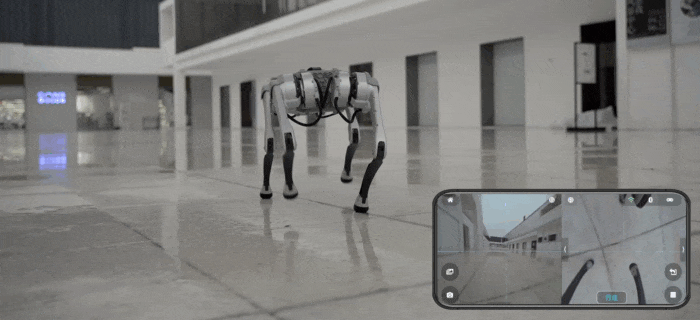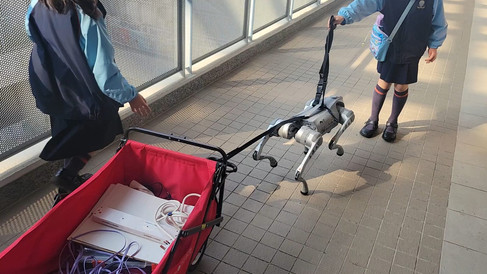UniTree@Innovation: A Robotic Revolution for Smart Campuses
- Coxana Admin

- Apr 16
- 3 min read
In this era of rapid technological advancement, smart campuses have emerged as a key focus in the education sector. How can cutting-edge technology be harnessed to solve real-world problems on campus, while inspiring creativity and critical thinking in students? The UniTree@Innovation course centers around the four-legged Unitree robot, integrating concepts of the “low-altitude economy” and guiding primary students to explore the boundless potential of technology, design thinking, and programming. Compared to drones, these quadrupedal robots offer greater stability and agility—ideal for solving campus-specific challenges such as navigating tight spaces and overcoming ground-level obstacles, paving the way for new possibilities in smart campus innovation.
Course Overview: A Journey of Technological Inspiration
Designed specifically for primary school students, the UniTree@Innovation program spans four sessions focused on hands-on exploration. The course unfolds in two phases: the first introduces students to the Unitree robot, and the second emphasizes design thinking and project presentation.
Phase One: Discovering the Secrets of Unitree Robots (Sessions 1–2)
Students will delve into the structure, operating principles, and industry applications of the Unitree robot—ranging from logistics and search-and-rescue to educational support. Through live demonstrations and case studies, they’ll gain an understanding of key components such as sensors and motors, and the engineering concepts behind them.
They’ll also be introduced to basic robotics programming using simplified tools to command the robot to walk, turn, or carry out simple tasks. Group activities allow students to operate the robots firsthand, sparking excitement and foundational awareness of real-world tech.
Phase Two: Design Thinking & Final Presentations (Sessions 3–4)
The second phase pivots to applying design thinking within a school setting. Students work in teams to identify campus problems and propose creative solutions through the following stages:
Define: Teams observe campus environments to uncover challenges—e.g., slow book delivery in the library or hard-to-reach cleaning areas.
Ideate & Prototype: Brainstorm how the Unitree robot could help and draft solution concepts, such as automated book transportation or targeted cleaning.
Code & Implement: Turn ideas into programmable robot tasks and test them in simulated environments.
Present: Teams create presentations to showcase their design concepts, programming process, and results to classmates and instructors, receiving feedback.
This phase nurtures logical thinking, programming skills, teamwork, and public speaking—boosting students' confidence and communication abilities.
Student Projects: Innovation in Action
Each group developed unique solutions using the Unitree robot to address real campus challenges:

Group 1 : Delivery Assistant
Designed a lightweight container to transport books or materials along a preset route.
Helped reduce the physical burden of item transport and improved internal logistics.

Group 2: Backpack Transporter
Mounted a rack simulating a backpack, allowing the robot to carry heavy schoolbags.
Beneficial for younger students; fostered understanding of load balancing and collaboration.

Group 3: Classroom Entertainer
Programmed the robot to perform jumps and simple dance moves to add fun to classroom settings.
Strengthened interest in motion control and robotics programming.

Group 4: Reception Greeter
Created an interactive greeting flow, including elevator navigation and voice messages.
Enhanced school image and deepened knowledge of environment-aware navigation.
Course Highlights & Value
Rooted in the principles of “Learn, Practice, Innovate,” UniTree@Innovation empowers students through:
Interdisciplinary Learning: Merges STEM with design thinking to build holistic skills.
Real-World Problem Solving: Uses campus challenges as teaching tools to explore tech's impact.
Team Collaboration & Presentation: Strengthens soft skills in teamwork and communication.
Low-Altitude Economy Insights: Positions quadruped robots as safer, more versatile alternatives to drones.
Why Choose Quadruped Robots?
Compared to drones, Unitree robots offer unique advantages in school environments:
Stability & Adaptability: Navigate complex terrains like stairs and grassy areas with ease.
Safety: Ground-based mobility reduces collision or crash risks, suitable for both indoor and outdoor use.
Interactivity: Lifelike movement engages students and enriches learning experiences.
Conclusion
More than just a robotics course, UniTree@Innovation is a hands-on gateway to smart campus exploration and 21st-century learning. From understanding the basics of robotics to designing real-world solutions, students experience the full innovation cycle. This not only lays a solid foundation for future STEM learning, but also equips them to meet tomorrow’s challenges with creativity and technical prowess.
Interested in bringing UniTree@Innovation to your school? We offer customized tech education programs based on age and learning goals. Contact us to design the perfect curriculum for your students!




























Comments